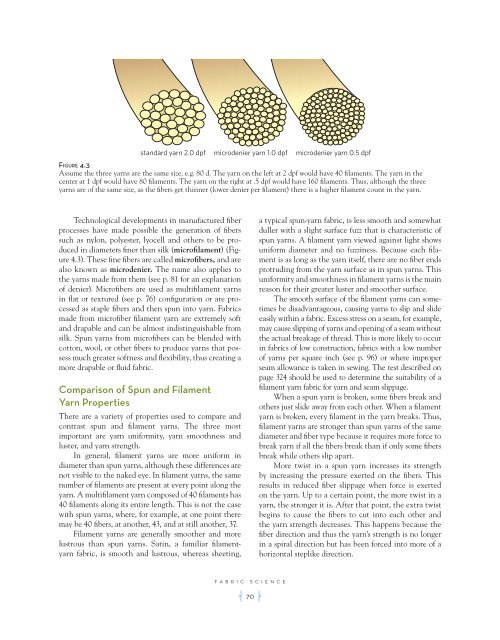You also want an ePaper? Increase the reach of your titles
YUMPU automatically turns print PDFs into web optimized ePapers that Google loves.
standard yarn 2.0 dpf microdenier yarn 1.0 dpf microdenier yarn 0.5 dpf<br />
Figure 4.3<br />
Assume the three yarns are the same size, e.g. 80 d. The yarn on the left at 2 dpf would have 40 filaments. The yarn in the<br />
center at 1 dpf would have 80 filaments. The yarn on the right at .5 dpf would have 160 filaments. Thus, although the three<br />
yarns are of the same size, as the fibers get thinner (lower denier per filament) there is a higher filament count in the yarn.<br />
Technological developments in manufactured fiber<br />
processes have made possible the generation of fibers<br />
such as nylon, polyester, lyocell and others to be produced<br />
in diameters finer than silk (microfilament) (Figure<br />
4.3). These fine fibers are called microfibers, and are<br />
also known as microdenier. The name also applies to<br />
the yarns made from them (see p. 81 for an explanation<br />
of denier). Microfibers are used as multifilament yarns<br />
in flat or textured (see p. 76) configuration or are processed<br />
as staple fibers and then spun into yarn. <strong>Fabrics</strong><br />
made from microfiber filament yarn are extremely soft<br />
and drapable and can be almost indistinguishable from<br />
silk. Spun yarns from microfibers can be blended with<br />
cotton, wool, or other fibers to produce yarns that possess<br />
much greater softness and flexibility, thus creating a<br />
more drapable or fluid fabric.<br />
Comparison of Spun and Filament<br />
Yarn Properties<br />
There are a variety of properties used to compare and<br />
contrast spun and filament yarns. The three most<br />
important are yarn uniformity, yarn smoothness and<br />
luster, and yarn strength.<br />
In general, filament yarns are more uniform in<br />
diameter than spun yarns, although these differences are<br />
not visible to the naked eye. In filament yarns, the same<br />
number of filaments are present at every point along the<br />
yarn. A multifilament yarn composed of 40 filaments has<br />
40 filaments along its entire length. This is not the case<br />
with spun yarns, where, for example, at one point there<br />
may be 40 fibers, at another, 43, and at still another, 37.<br />
Filament yarns are generally smoother and more<br />
lustrous than spun yarns. Satin, a familiar filamentyarn<br />
fabric, is smooth and lustrous, whereas sheeting,<br />
FABRIC SCIENCE<br />
A 70 F<br />
a typical spun-yarn fabric, is less smooth and somewhat<br />
duller with a slight surface fuzz that is characteristic of<br />
spun yarns. A filament yarn viewed against light shows<br />
uniform diameter and no fuzziness. Because each filament<br />
is as long as the yarn itself, there are no fiber ends<br />
protruding from the yarn surface as in spun yarns. This<br />
uniformity and smoothness in filament yarns is the main<br />
reason for their greater luster and smoother surface.<br />
The smooth surface of the filament yarns can sometimes<br />
be disadvantageous, causing yarns to slip and slide<br />
easily within a fabric. Excess stress on a seam, for example,<br />
may cause slipping of yarns and opening of a seam without<br />
the actual breakage of thread. This is more likely to occur<br />
in fabrics of low construction, fabrics with a low number<br />
of yarns per square inch (see p. 96) or where improper<br />
seam allowance is taken in sewing. The test described on<br />
page 324 should be used to determine the suitability of a<br />
filament yarn fabric for yarn and seam slippage.<br />
When a spun yarn is broken, some fibers break and<br />
others just slide away from each other. When a filament<br />
yarn is broken, every filament in the yarn breaks. Thus,<br />
filament yarns are stronger than spun yarns of the same<br />
diameter and fiber type because it requires more force to<br />
break yarn if all the fibers break than if only some fibers<br />
break while others slip apart.<br />
More twist in a spun yarn increases its strength<br />
by increasing the pressure exerted on the fibers. This<br />
results in reduced fiber slippage when force is exerted<br />
on the yarn. Up to a certain point, the more twist in a<br />
yarn, the stronger it is. After that point, the extra twist<br />
begins to cause the fibers to cut into each other and<br />
the yarn strength decreases. This happens because the<br />
fiber direction and thus the yarn’s strength is no longer<br />
in a spiral direction but has been forced into more of a<br />
horizontal steplike direction.













